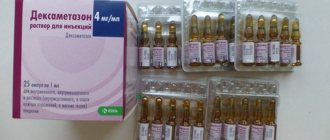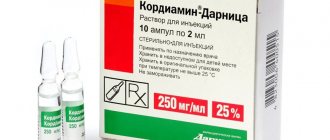Pharmacological properties of the drug Halidor
Halidor has a myotropic antispasmodic and vasodilator effect. Reduces the tone and motor activity of smooth muscles of internal organs. The blood pressure level is slightly affected. Has weak local anesthetic activity. Causes a moderate sedative effect. Inhibits platelet aggregation. Quickly and completely absorbed into the gastrointestinal tract. The maximum concentration in blood plasma is achieved 3 hours after administration. The half-life is 6 hours. About 97% of the dose taken is excreted in the urine in the form of inactive metabolites.
Halidor 25 mg/ml 2 ml No. 10 solution d/in.amp.
Instructions for medical use of the drug GALIDOR Trade name Galidor International nonproprietary name Bencyclane Dosage form Solution for injection, 25 mg/ml Composition 1 ml of solution contains the active substance - bencyclane fumarate 25 mg, excipients: sodium chloride, water for injection. Description Transparent, odorless aqueous solution. Pharmacotherapeutic group Other peripheral vasodilators. Bencyclane. ATC code C04A X11 Pharmacological properties Pharmacokinetics Maximum concentration in blood plasma is achieved 2-8 hours (usually 3 hours) after oral administration. Due to first-pass metabolism through the liver, the bioavailability of the drug after oral administration is 25-35%. Approximately 30-40% of the amount of bencyclane in the circulating blood is associated with plasma proteins, 30% with erythrocytes, 10% with platelets; the free fraction is 20%. Metabolism occurs in the liver, mainly in two ways: dealkylation produces a demethylated derivative, cleavage of the ester bond produces benzoic acid, which is subsequently converted to hippuric acid. The main part of the administered dose is excreted by the kidneys, mainly in the form of metabolites, but also unchanged (2-3%). The vast majority of metabolites (90%) are excreted in unconjugated form, and a small part is excreted in conjugated form (approximately 50% as a conjugate with glucuronic acid). Half-life 6-10 hours; this parameter does not change in elderly patients, as well as in cases of impaired renal and liver function. The total clearance is 40 l/h, renal clearance is less than 1 l/h. Pharmacodynamics Halidor has a vasodilatory effect, which is mainly associated with its ability to block calcium channels and, to a lesser extent, with blockade of sympathetic ganglia. There is evidence indicating the ability of bencyclane to cause dose-dependent suppression of Na/K-ATPase and platelet aggregation, as well as an increase in the ability of red blood cells to deform. These effects are observed mainly in peripheral vessels, coronary arteries and cerebral vessels. In addition, Halidor has an antispasmodic effect on the smooth muscles of the gastrointestinal tract, genitourinary organs, and respiratory tract. The drug causes a slight increase in heart rate. Its weak tranquilizing effect is also known. Indications for use Vascular diseases: - peripheral vascular diseases: Raynaud's disease, other diseases accompanied by acrocyanosis and vasospasm, as well as conditions caused by arterial occlusion - as part of complex therapy for cerebrovascular disorders Elimination of spasm of internal organs: - gastrointestinal diseases: gastroenteritis of various etiologies (especially infectious), infectious and inflammatory colitis, functional diseases of the large intestine, tenesmus, postoperative flatulence, cholecystitis, cholelithiasis, condition after cholecystectomy, motility disorders with dyskinesia of the sphincter of Oddi, peptic ulcer of the stomach and duodenum in combination with other drugs - urological syndromes: bladder tenesmus, additional therapy for urolithiasis (in combination with analgesics for renal colic), preparation for instrumental research methods. Method of administration and dosage. Solution for intramuscular or intravenous (after dilution) administration, as well as for infusion. For intravenous administration, the contents of the ampoule should be diluted with 0.9% sodium chloride solution. Vascular diseases: administration by infusion in a daily dose of 200-300 mg, divided into 2-3 infusions; the infusion should be given slowly over approximately 1 hour. Elimination of spasm of internal organs: in acute forms of the disease, 2-4 ampoules of the drug diluted with saline to 10-20 ml or 50 mg intramuscularly are administered slowly intravenously. The duration of treatment is determined by the doctor individually depending on the clinical condition of the patient. Opening ampoules (for right-handers): Take the body of the ampoule in your left hand, between your thumb and bent index finger. The breaking point should be at the top (Fig. 1). Hold the head of the ampoule between the thumb and bent index finger of your right hand so that the thumb is at the break point, covering it (Fig. 2). Leaning on the index finger of your left hand, press the ampoule with the thumb of your right hand, thus exerting constant pressure of medium strength. Do not bring your right and left hands closer or further away from each other (Fig. 3). The neck of the ampoule may crack at any time after pressing, which you may not feel. Side effects - dry mouth, stomach pain, feeling of fullness, nausea, vomiting - sporadic restlessness, headache, dizziness, gait disturbance, tremor, drowsiness, sleep disturbance , memory impairment - tonic and clonic convulsions in case of significant overdose - transient increase in the activity of liver enzymes, leukopenia - general malaise, increase in body weight - thrombophlebitis (with intravenous administration) Possibly - atrial or ventricular tachyarrhythmia (especially when administered together with other proarrhythmogenic drugs) - allergic reactions Very rare - symptoms of focal damage to the central nervous system Contraindications - hypersensitivity to the active or other component of the drug - severe respiratory, renal or hepatic failure - decompensated heart failure, acute myocardial infarction, atrioventricular block - epilepsy, various forms of spasmophilia - recently history of stroke - traumatic brain injury in the last 12 months - pregnancy and lactation (relative contraindication) - children under 18 years of age Drug interactions Caution should be exercised when combined with the following drugs: - anesthetics and sedatives (their effects may be enhanced) - sympathomimetics ( due to the risk of atrial and ventricular tachyarrhythmias) - drugs that reduce potassium levels in the blood, quinidine (due to the possible summation of proarrhythmogenic effects) - digitalis preparations (the risk of arrhythmia increases with an overdose of digitalis) - β-blockers (due to the opposite chronotropic effects - (negative for β-blockers and positive for bencyclane) it may be necessary to adjust the dosage of the β-blocker) - calcium channel blockers and other antihypertensive drugs (due to the possibility of additive effects of these effects) - with drugs with an adverse reaction that increases spasmophilia (due to - for the possibility of summation of these effects) - aspirin (due to increased inhibition of platelet aggregation) Special instructions Injection sites should be changed periodically, as the drug can cause damage to the vascular endothelium and thrombophlebitis. You should refrain from parenteral administration of the drug to patients with cardiovascular and respiratory failure, predisposed to collapse, as well as prostatic hypertrophy and urinary retention (the degree of retention increases with relaxation of the bladder muscles). During long-term therapy, regular laboratory tests are recommended (at least once every two months). Pregnancy and lactation Despite the absence of embryotoxic effects with widespread use of the drug, use of the drug in the first trimester of pregnancy is not recommended. Due to the lack of reliable data, the use of the drug during breastfeeding requires special caution. Features of the effect of the drug on the ability to drive a vehicle or potentially dangerous mechanisms. At the beginning of the course of treatment, driving and engaging in potentially hazardous activities that require increased concentration and speed of psychomotor reactions require special caution. Overdose Symptoms: increased heart rate, decreased blood pressure, predisposition to collapse, urinary incontinence, drowsiness, anxiety, psychomotor agitation, and in severe cases, epileptiform seizures. Treatment: specific antidote is unknown. Symptomatic therapy, gastric lavage. When seizures develop, it is recommended to use benzodiazepines. There is no data on the possible removal of bencyclane by dialysis. Release form and packaging 2 ml in ampoules made of colorless neutral glass with a break point. A code ring of blue (lower ring) and light yellow (upper ring) is applied to the rim of the ampoules with indelible paint. A self-adhesive paper label is placed on each ampoule. 5 ampoules are placed in a blister pack made of PVC film and PET/PE film. 2 blister packs together with instructions for medical use in the state and Russian languages are placed in a cardboard pack. Storage conditions Store at temperatures from 15 ºС to 25 ºС! Keep out of the reach of children! Shelf life 3 years Do not use after expiration date. Conditions for dispensing from pharmacies By prescription 1106 BUDAPEST, st. Keresturi, 30-38 Hungary Phone: (36-1) 803-5555, fax: (36-1) 803-5529 Registration certificate owner JSC "EGIS Pharmaceutical Plant", Hungary Address of the organization accepting claims from consumers on the territory of the Republic of Kazakhstan quality of products (goods) Representative office in the Republic of Kazakhstan CJSC "EGIS Pharmaceutical Plant" 050060, Almaty, st. Zharokova 286 G tel: +, +, fax: + 7 (727) 247 61 41, e-mail
Indications for use of the drug Halidor
The drug is used to treat:
- cerebrovascular accidents of various origins;
- to relieve neurological symptoms (dizziness, headache, sleep disturbance, etc.);
- cerebral angiospastic syndromes;
- peripheral circulatory disorders;
- vascular diseases of the eyes;
- arterial spasm, postoperative and post-traumatic circulatory disorders, etc.;
- obliterating diseases (obliterating arteriosclerosis, diabetic angiopathy).
In cardiology:
- to increase heart rate with mild sinus node weakness;
- with sinus bradycardia, symptoms of vagotonic influence on the heart;
- as an auxiliary therapy for ischemic heart disease.
Visceral spasm:
- gastrointestinal vasospasm, gastritis, enteritis, colitis, tenesmus, cholecystopathy, cholelithiasis, postcholecystectomy syndrome.
In urology:
- Bladder tenesmus as an auxiliary therapy for nephrolithiasis.
Use of the drug Halidor
Tablets For periodic use, a single dose is 1-2 tablets (100-200 mg), a daily dose is 300-400 mg, a maximum daily dose is 4 tablets (400 mg). Long-term treatment: 3 tablets (300 mg) per day for 3–4 weeks, then 1 tablet (100 mg) 2 times a day. Injection solution For adults: in acute cases, 50–100 mg (1–2 ampoules) IV, intra-arterial slow stream or 50 mg (1 ampoule) IM 1–2 times a day. The drug is diluted with physiological solution. The daily dose of Halidor should not exceed 150–200 mg.
Contraindications
The drug has a number of contraindications. These include hypersensitivity to bencyclane, cases of severe respiratory, renal, cardiac and hepatic failure, existing atrioventricular block or acute myocardial infarction.
Halidor is not used in cases of epilepsy, other forms of spasmophilia, as well as in cases of hemorrhagic stroke or severe traumatic brain injury suffered in the last year.
Due to the lack of reliable research on the use of Halidor in pregnant and lactating women, the use of Halidor is not recommended in the first trimester of pregnancy. It is also advisable to discontinue use during breastfeeding or stop breastfeeding for the entire duration of treatment.
Special instructions for the use of the drug Halidor
Before prescribing the drug, liver and kidney function should be determined. When carrying out long-term therapy, it is necessary to monitor the hemogram every 2 months. Take with caution in case of prostate adenoma with impaired urine outflow. Restrictions in driving vehicles and other mechanisms depend on the individual characteristics of the patient (presence of sedation). It is not recommended to use the drug for the treatment of children and adolescents under the age of 18 years. When administering the drug parenterally, the injection sites should be changed to avoid damage to the vascular endothelium or the occurrence of thrombophlebitis.
Side effects
Side effects from the gastrointestinal tract may include abdominal pain, a feeling of fullness, nausea, and vomiting. From the side of the central nervous system: anxiety, dizziness, gait disturbance, tremor, headache, insomnia, very rarely hallucinations may develop.
There may be cases of tachyarrhythmia (ventricular or atrial; the development is significantly more common when used together with other proarrhythmogenic drugs).
Other side effects can be expressed in a state of general malaise, weight gain, allergic reactions, transient increases in the activity of ASAT, ALAT, as well as a decrease in the number of leukocytes; there is rarely a possibility of thrombophlebitis with intravenous administration.
Overdose
An overdose of Halidor is rare. Symptoms in case of overdose: tachycardia, drop in blood pressure, drowsiness, urinary incontinence; in case of severe overdose, epileptiform seizures are possible.
Due to the lack of a specific antidote, in cases of overdose, symptomatic therapy is used. Benzodiazepines are indicated to relieve seizures. The effectiveness of dialysis for bencyclane overdose is questionable, but there is no reliable data.


